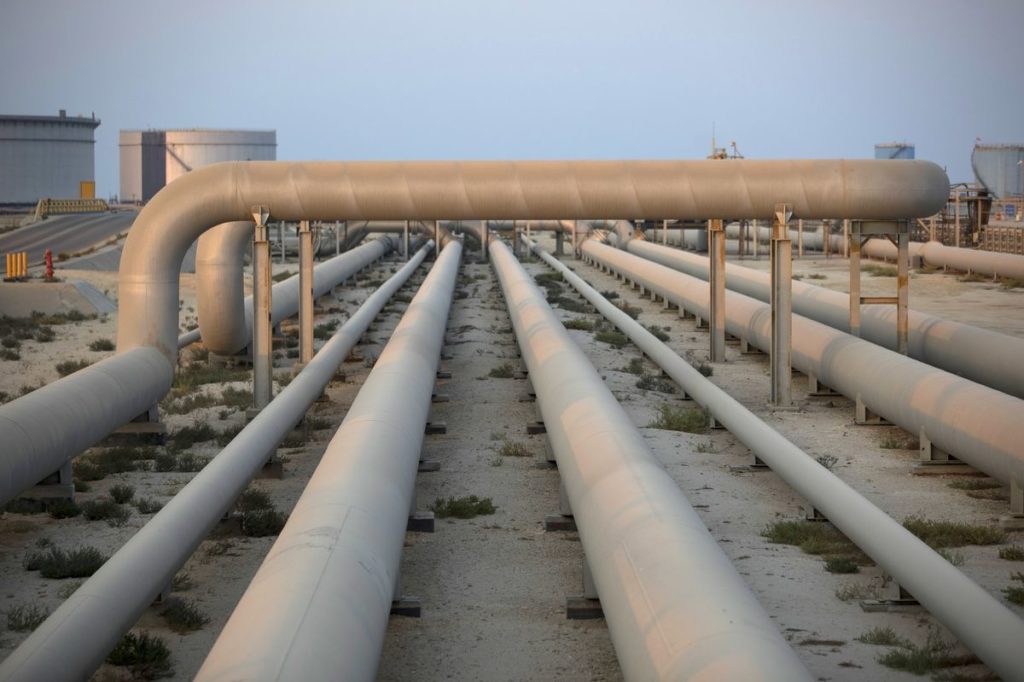
Oil futures plunged as much as 26% to the lowest levels since 2002 after Saudi Arabia vowed to keep producing at a record high “over the coming months,” doubling down in its price war with Russia.
For the last 10 days, Riyadh has issued nearly daily statements raising the stakes in its shock-and-awe battle with Moscow, first announcing record price discounts, then unprecedented production. The kingdom is now vowing to pump flat out for months to come. The energy market has taken these as a green light to sell, sending prices down about 45% since a failed OPEC+ meeting this month.
“What we are seeing here is essentially the atomic bomb equivalent in the oil markets,” said Louise Dickson, an analyst at Rystad Energy A/S, in an email. “With each day there seems to be yet another trap door lying beneath oil prices, and we expect to see prices continue to roil until a cost equilibrium is reached and production is shut in.”
Riyadh appears to be heading to a Darwinian survival of the fittest for the energy industry, in which the highest cost producers, including U.S. shale companies and others working Brazil’s offshore fields, will suffer enormously. The Saudi Ministry of Energy “directed Saudi Aramco to continue to supply crude oil at a level of 12.3 million barrels a day over the coming months,” according to a statement.
Russia so far has suggested it’s prepared to absorb the pain, although for the first time on Wednesday the Kremlin said it would prefer higher prices. Yet, few in the oil market see either Moscow or Riyadh taking a u-turn.
Saudi Arabia “wants to keep the pressure high,” said UBS commodity analyst Giovanni Staunovo. “It seems to me they want to trigger so much pain to Russia and the other producers, to eventually have a new production deal at a later stage. That policy might create a lot damage in between.”
West Texas Intermediate futures in New York fell as much as 26% to $20.06 a barrel, the lowest since February 2002. Oil is now cheaper than any time during the global financial crisis, when the world economy largely came to halt for a few days. Demand is in free fall, with some traders saying it could drop by more than 10% compared with last year.
Brent futures plunged as much as 15% to $24.52 a barrel, the lowest since 2003. Gasoline, diesel and jet-fuel wholesale prices also fell.
In the physical market, the pain is enormous. The Mexican oil basket, which measures the price the country secures selling its crude overseas, fell to $18.78 a barrel on Monday. In Canada, the benchmark crude price for tar-sands producers, known as Western Canadian Select, plunged to $8.53 a barrel at 1:14pm ET.
“This is new territory,” said Brian Kessens, portfolio manager at Tortoise. “It’s clear Russia wanted to impair U.S. shale and E&P companies are really going to suffer. The more we see aggressive rhetoric from Saudi Arabia and Russia, the weaker crude oil is going to get.”
The market is finding little succor from global efforts to stem the economic fallout of the fast spreading coronavirus. The U.S. Federal Reserve on Tuesday announced the restart of a financial crisis-era program to stem the impact from the virus, but equities and bonds are continuing to drop.
The supply and demand shocks have hammered Wall Street’s outlook for oil. Goldman Sachs Group Inc. said consumption is down by 8 million barrels a day and cut its Brent forecast for the second quarter to $20 a barrel. Citi also lowered its bear-case forecast saying Brent could average $17 a barrel or lower in the second quarter, while Mizuho Securities warned prices could go negative as Russia and Saudi Arabia flood the market.
The rout amid ruthless competition between exporters has prompted Iraq to urge OPEC and its allies to regroup for negotiations. Before OPEC+ talks collapsed earlier this month, Iraq had routinely disregarded the supply cutbacks it had promised. Now the producer has asked the cartel to hold a meeting to consider steps for re-balancing the global oil market, according to a delegate.
Recommended for you
